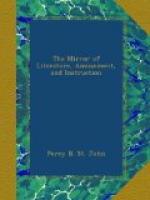“One night we encamped on the foundation of an old Red Indian wigwam, on the extremity of a point of land which juts out into the lake, and exposed to the view of the whole country around. A large fire at night is the life and soul of such a party as ours, and when it blazed up at times, I could not help observing that two of my Indians evinced uneasiness and want of confidence in things around, as if they thought themselves usurpers on the Red Indian territory. From time immemorial none of the Indians of the other tribes had ever encamped near this lake fearlessly, and, as we had now done, in the very centre of such a country; the lake and territory adjacent having been always considered to belong exclusively to the Red Indians, and to have been occupied by them. It had been our invariable practice hitherto, to encamp near the hills, and be on their summits by the dawn of day, to try to discover the morning smoke ascending from the Red Indians’ camps; and to prevent the discovery of ourselves, we extinguished our own fire always some length of time before daylight.”
“Our only and frail hope now left of seeing the Red Indians, lay on the banks of the River Exploits, on our return to the sea-coast.”
“The Red Indians’ Lake discharges itself about three or four miles from its north-east end, and its waters form the River Exploits. From the lake to the sea-coast is considered about seventy miles; and down this noble river the steady perseverance and intrepidity of my Indians carried me on rafts in four days, to accomplish which otherwise, would have required, probably, two weeks. We landed at various places on both banks of the river on our way down, but found no traces of the Red Indians so recent as those seen at the portage at Badger Bay-Great Lake, towards the beginning of our excursion. During our descent, we had to construct new rafts at the different waterfalls. Sometimes we were carried down the rapids at the rate of ten miles an hour, or more, with considerable risk of destruction to the whole party, for we were always together on one raft.”
“What arrests the attention most, while gliding down the stream, is the extent of the Indian fences to entrap the deer. They extend from the lake downwards, continuous, on the banks of the river, at least thirty miles. There are openings left here and there in them, for the animals to go through and swim across the river, and at these places the Indians are stationed, and kill them in the water with spears, out of their canoes, as at the lake. Here, then, connecting these fences with those on the north-west side of the lake, is at least forty miles of country, easterly and westerly, prepared to intercept all the deer that pass that way in their periodical migrations. It was melancholy to contemplate the gigantic, yet feeble, efforts of a whole primitive nation, in their anxiety to provide subsistence, forsaken and going to decay.”
“There must have been hundreds of the Red Indians, and that not many years ago, to have kept up these fences and pounds. As their numbers were lessened so was their ability to keep them up for the purposes intended; and now the deer pass the whole line unmolested.”




